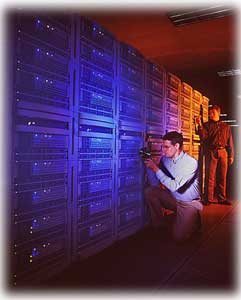
11.8T HP supercomputer with Intel Itanium2 processors running Linux reaches full operations. August 27, 2003
Based on peak performance, the PNNL machine is the fifth fastest system in the world and is the fastest unclassified computer operating in the U.S. The laboratory ordered the supercomputer from HP in April 2002. "Computational resources such as the PNNL supercomputer are essential to DOE's commitment to provide the most innovative solutions to critical energy and environmental problems," said Secretary of Energy Spencer Abraham. "DOE continues to demonstrate its competitiveness in high-performance computing capabilities by investing in new systems and new approaches to scientific inquiry." The PNNL system is the world's fastest supercomputer based on the Linux operating system and is the largest machine ever built using Intel's 64-bit architecture. "With this machine, PNNL is providing a balanced architecture that is designed specifically for environmental, chemical and biological sciences and the priorities of DOE's Office of Science," said PNNL Director Len Peters. "The laboratory led the supercomputer industry by ordering one of the first large cluster systems in 1996, and has once again demonstrated that an investment in mission-focused computing can open new scientific frontiers. We're pleased we could partner with HP on such an accomplishment." PNNL's supercomputer draws its speed and computing power from nearly 2,000 next-generation Intel® Itanium®-2 processors code-named "Madison," running on industry-standard HP Integrity servers. Linking the Intel Itanium2 chips is a Quadrics interconnect that provides communication between processors and allows scientists to sustain a high performance level. HP is providing services to customers that help manage, deploy and enhance the power and ability of supercomputing. "HP and PNNL are working together to create next-generation technical computing solutions that will support some of the world's most important scientific research," said Martin Fink, vice president of Linux, HP Enterprise Servers and Storage. "The world's fastest Linux supercomputer runs on industry-standard HP platforms and the recently unveiled Madison processor, and was created by a joint effort between PNNL and the many hardware, software and services professionals within the HP organization." 
According to Scott Studham, who manages computer operations within the MSCF, "We chose the HP system during our competitive procurement process because its overall system balance was best tailored to the needs of the complex computational chemistry done at PNNL. The additional power and speed will enable novel studies in atmospheric chemistry, systems biology, catalysis and materials science." Pacific Northwest National Laboratory is a Department of Energy Office of Science facility that is gaining new knowledge through fundamental research and providing science-based solutions to some of the nation's most pressing challenges in national security, energy and environmental quality. The laboratory employs more than 3,800 scientists, engineers, technicians and support staff, and has an annual budget of nearly $600 million. Battelle, based in Columbus, Ohio, has operated PNNL since its inception in 1965 for the federal government. DOE's Office of Science is
the single largest supporter of basic research in the physical
sciences in the nation, manages 10 world-class national laboratories
and builds and operates some of the nation's most advanced research
and development user facilities. More information about the Office
of Science is available at www.science.doe.gov.
Source of News Release & Photos:
|
||
